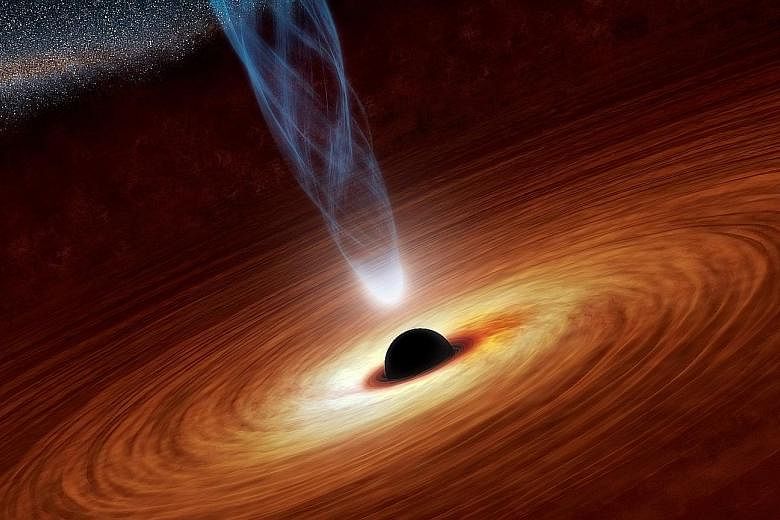PARIS • The world, it seems, is soon to see the first picture of a black hole.
On Wednesday, astronomers across the globe will hold "six major press conferences" simultaneously to announce the first results of the Event Horizon Telescope (EHT), which was designed precisely for that purpose.
It has been a long wait.
Of all the forces or objects in the universe that we cannot see - including dark energy and dark matter - none has frustrated human curiosity so much as the invisible maws that shred and swallow stars like so many specks of dust.
Astronomers began speculating about these omnivorous "dark stars" in the 1700s, and since then indirect evidence has slowly accumulated.
"More than 50 years ago, scientists saw that there was something very bright at the centre of our galaxy," Mr Paul McNamara, an astrophysicist at the European Space Agency and an expert on black holes, told Agence France-Presse (AFP).
"It has a gravitational pull strong enough to make stars orbit around it very quickly - as fast as 20 years."
To put that in perspective, our solar system takes about 230 million years to circle the centre of the Milky Way.
Eventually, astronomers speculated that these bright spots were in fact "black holes" - a term coined by American physicist John Archibald Wheeler in the mid-1960s - surrounded by a swirling band of white-hot gas and plasma.
At the inner edge of these luminous accretion disks, things abruptly go dark.
"The event horizon" - or the point-of-no-return - "is not a physical barrier, you couldn't stand on it", Mr McNamara explained. "If you're on the inside of it, you can't escape because you would need infinite energy. And if you are on the other side, you can - in principle."
At its centre, the mass of a black hole is compressed into a single, zero-dimensional point. The distance between this so-called "singularity" and the event horizon is the radius, or half the width, of a black hole.
The EHT that collected the data for the first image is unlike any ever devised.
"Instead of constructing a giant telescope - which would collapse under its own weight - we combined several observatories as if they were fragments of a giant mirror," Mr Michael Bremer, an astronomer at the Institute for Millimetric Radio Astronomy in Grenoble, told AFP.
In April 2017, eight such radio telescopes scattered across the globe - in Hawaii, Arizona, Spain, Mexico, Chile and the South Pole - were trained on two black holes in very different parts of the universe to collect data. Studies that could be unveiled this week are likely to zoom in on one or the other.
Odds makers favour Sagittarius A*, the black hole at the centre of our own elliptical galaxy that first caught the eye of astronomers.
Sag A* has four million times the mass of the sun, which means that the black hole it generates is about 44 million kilometres across.
The other candidate is a monster black hole - 1,500 times more massive than Sag A* - in an elliptical galaxy known as M87.
AGENCE FRANCE-PRESSE

